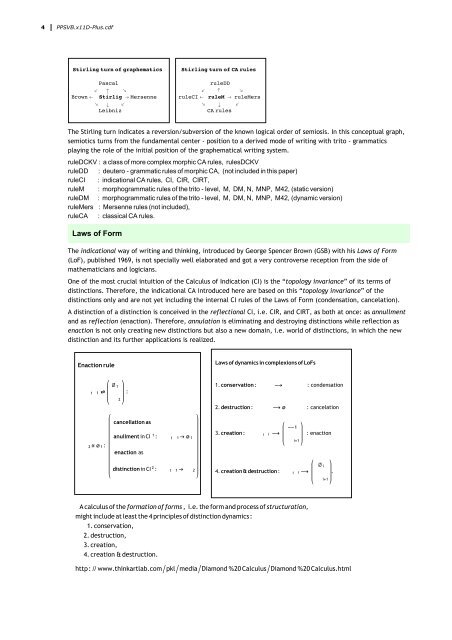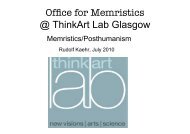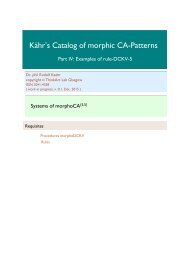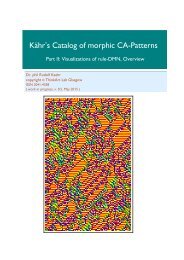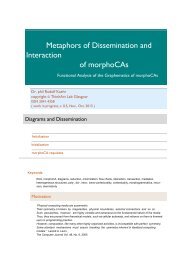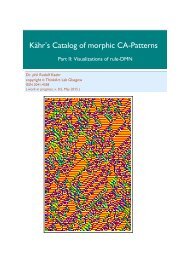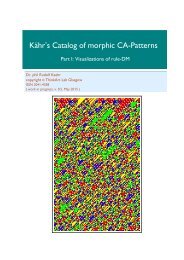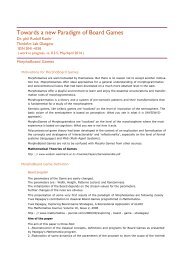A Kind of a New Music Box
A Tool Box for sonic and visual deep-structural adventures by comparing classical, indicational and morphic CA. Motto: If words are not going to be listened to and notions are not going to be understood, there is still a chance of showing some pictures and making some noise, with an offer to motivate to enjoy or to conceive their differences and also to try to overcome the attitude of blind and deaf denial of conceptual thinking. Interactivity for Sound and Visualizations needs the formats Wolfram CDF or HTML. http://www.thinkartlab.com/Memristics/PPSVB-Plus/PPSVB.x11D-Plus.html , soundtracks at: https://soundcloud.com/morphicalgorithms/tracks, more information at: http://the-chinese-challenge.blogspot.co.uk
A Tool Box for sonic and visual deep-structural adventures
by comparing classical, indicational and morphic CA.
Motto:
If words are not going to be listened to and notions are not going to be understood, there is still a chance of showing some pictures and making some noise, with an offer to motivate to enjoy or to conceive their differences and also to try to overcome the attitude of blind and deaf denial of conceptual thinking. Interactivity for Sound and Visualizations needs the formats Wolfram CDF or HTML. http://www.thinkartlab.com/Memristics/PPSVB-Plus/PPSVB.x11D-Plus.html , soundtracks at:
https://soundcloud.com/morphicalgorithms/tracks, more information at: http://the-chinese-challenge.blogspot.co.uk
Create successful ePaper yourself
Turn your PDF publications into a flip-book with our unique Google optimized e-Paper software.
4 PPSVB.x11D-Plus.cdf<br />
Stirling turn <strong>of</strong> graphematics<br />
Pascal<br />
↙ ↘<br />
Brown ← Stirlig → Mersenne<br />
↘ ↙<br />
Leibniz<br />
Stirling turn <strong>of</strong> CA rules<br />
ruleDD<br />
↙ ↑ ↘<br />
ruleCI ← ruleM → ruleMers<br />
↘<br />
↙<br />
CA rules<br />
The Stirling turn indicates a reversion/subversion <strong>of</strong> the known logical order <strong>of</strong> semiosis. In this conceptual graph,<br />
semiotics turns from the fundamental center - position to a derived mode <strong>of</strong> writing with trito - grammatics<br />
playing the role <strong>of</strong> the initial position <strong>of</strong> the graphematical writing system.<br />
ruleDCKV : a class <strong>of</strong> more complex morphic CA rules, rulesDCKV<br />
ruleDD : deutero - grammatic rules <strong>of</strong> morphic CA, (not included in this paper)<br />
ruleCI : indicational CA rules, CI, CIR, CIRT,<br />
ruleM : morphogrammatic rules <strong>of</strong> the trito - level, M, DM, N, MNP, M42, (static version)<br />
ruleDM : morphogrammatic rules <strong>of</strong> the trito - level, M, DM, N, MNP, M42, (dynamic version)<br />
ruleMers : Mersenne rules (not included),<br />
ruleCA : classical CA rules.<br />
Laws <strong>of</strong> Form<br />
The indicational way <strong>of</strong> writing and thinking, introduced by George Spencer Brown (GSB) with his Laws <strong>of</strong> Form<br />
(LoF), published 1969, is not specially well elaborated and got a very controverse reception from the side <strong>of</strong><br />
mathematicians and logicians.<br />
One <strong>of</strong> the most crucial intuition <strong>of</strong> the Calculus <strong>of</strong> Indication (CI) is the “topology invariance” <strong>of</strong> its terms <strong>of</strong><br />
distinctions. Therefore, the indicational CA introduced here are based on this “topology invariance” <strong>of</strong> the<br />
distinctions only and are not yet including the internal CI rules <strong>of</strong> the Laws <strong>of</strong> Form (condensation, cancelation).<br />
A distinction <strong>of</strong> a distinction is conceived in the reflectional CI, i.e. CIR, and CIRT, as both at once: as annullment<br />
and as reflection (enaction). Therefore, annulation is eliminating and destroying distinctions while reflection as<br />
enaction is not only creating new distinctions but also a new domain, i.e. world <strong>of</strong> distinctions, in which the new<br />
distinction and its further applications is realized.<br />
Enaction rule<br />
Laws <strong>of</strong> dynamics in complexions <strong>of</strong> LoFs<br />
∅ 1<br />
2<br />
1 1 ⇄<br />
:<br />
1. conservation : ⟶ : condensation<br />
2. destruction : ⟶ ⌀ : cancelation<br />
2 ≅ ⌀ 1 :<br />
cancellation as<br />
anullment in CI 1 : 1 1 → ⌀ 1<br />
enaction as<br />
3. creation : i i ⟶<br />
-- i<br />
i+1<br />
: enaction<br />
distinction in CI 2 : 1 1 → 2<br />
4. creation & destruction : i i ⟶<br />
.<br />
∅ i<br />
i+1<br />
A calculus <strong>of</strong> the formation <strong>of</strong> forms , i.e. the form and process <strong>of</strong> structuration,<br />
might include at least the 4 principles <strong>of</strong> distinction dynamics:<br />
1. conservation,<br />
2. destruction,<br />
3. creation,<br />
4. creation & destruction.<br />
http: // www.thinkartlab.compklmediaDiamond %20 CalculusDiamond %20 Calculus.html


